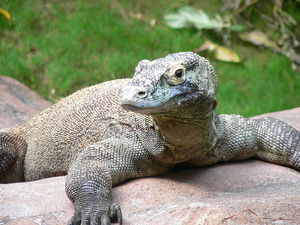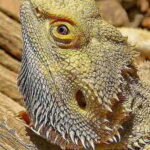It was 1912 when a group of pearl fishermen in the area came back with reports of the Komodo dragon. It was the first time anyone had ever reported the presence of the beast. A scientific expedition was dispatched shortly thereafter from Java and confirmed the existence of these incredible creatures. Now they appear occasionally on documentaries and can be found occasionally at the zoo. Here’s a set of amazine facts about these fascinating animals.
LARGEST LIZARD. The Komodo dragon is the largest and heaviest of about 30 different monitor species, such as the Nile monitor. The Komodo dragon reaches up to 10 feet in length and is an ambush predator. There are unconfirmed reports of related dragons in the jungles of northern Australia up to three times larger (30 feet) then the Komodo. Something similar to the Komodo has been found in the Pleistocene fossil record in Queensland, believed to have disappeared 19,000 years ago although the maximum length tens to be about twice as large as a Komodo at 20 feet.
MAN EATERS. Komodo dragons have been known to attack and eat people. There is a report of a Swiss tourist who sat to rest as his tour group continued. Only a piece of his camera was found on the beach. An Indonesian fisherman in search of fruit on one of the islands inhabited by Komodos was killed in March 2009.
FOOD. Komodos are apex predators, top of their local food chain. They prey mainly on wild deer and boar, but also target other live prey. They can consume an amazing 80% of their body weight in one meal. They eat by ripping away meat and swallowing it whole. When they eat, they eat everything…flesh, bone, fur, and hooves. They are aided by a snakelike ability to unhinge their lower jaws to help swallow food.
NUMBERS. Because Komodos are reptiles, they don’t feed as often as mammalian predators. So an ecosystem that would only support a few dozen carnivorous tigers, for example, can support 4,000-5,000 cold-blooded Komodo dragons, of which only 350 are breeding females. The numbers are not much changed from earlier times, but it’s their small ecohabitat makes them vulnerable which is why they are protected.
KOMODO HOMELAND. Komodos are protected, but not doubt lasted this long because of their isolation on the Indonesian islands of Komodo, Rinca, Padar, Flores, and the Sunda Islands.
POISONOUS BITE. Komodo dragons drool a lot and that saliva is rich in infectious bacteria. The infection can be fatal if untreated. If they can’t take down their prey immediately, any bite wound will become infected as they stalk their prey. Recent studies have found venomous glands in the mouth of the Komodo which emit an anti-coagulant in the bite wound which encourages continued bleeding and further weakening. When a prey animal is sufficiently weakened by infection and the venom, Komodos move in for the kill. Komodos appear to be immune to the infection from the bite of a fellow Komodo.
TONGUE. The Komodo has a long, forked tongue like a snake and, like a snake, can follow a scent trail with its tongue.
BREATHING. Lizards often are unable to breathe efficiently as they run due to the placement of rib muscles. Monitors can do so because they have a “gular pouch” under their chins that fills with air which can be pumped down into the lungs.
SPRINTERS. Komodos are cold-blooded reptiles so, like all such creatures, they minimize their activity until needed. However, like aligators and crocodiles, they can call up energy reserves for fast sprints when needed.
TREE DWELLERS. Young Komodos under a couple years old spend much of their time in trees as a self-defense measure. Older, bigger Komodos would run them down and eat them otherwise. The adult Komodos will also cannibalize their peers given the chance.



